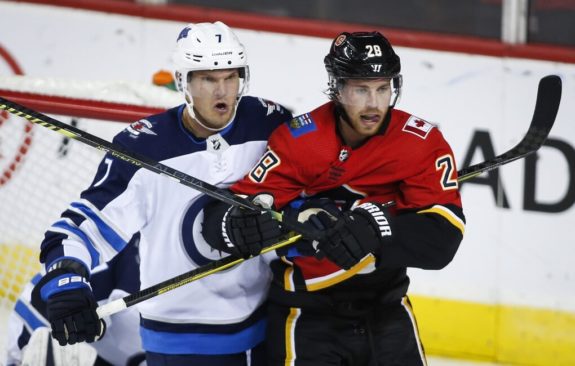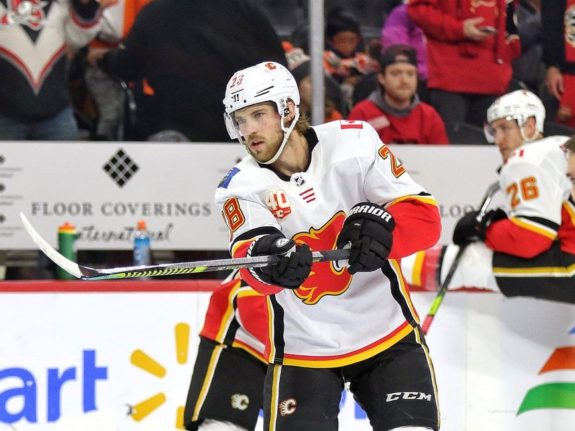Quietly consistent is one way you could describe Elias Lindholm’s type of game over the 2020-21 season. In a season full of disappointment for the Calgary Flames, he had himself a third personally successful season. He became the club’s bonafide number one center after playing two seasons on the right wing. His line with Johnny Gaudreau and Matthew Tkachuk became the Flames’ newest top-line and they performed well during the latter parts of the campaign.
Having become the team’s number one center, Lindholm was also a staple on the first power-play unit and the penalty kill. He has become a very versatile forward for the Flames who can play in all situations and had a rebound year after the 2019-20 season. Moving forward into next season, he will be relied upon heavily once again playing in all situations. If this season was any indication, he should be the team’s number one center moving forward.
Lindholm Back at Center
The Swedish-born forward hadn’t played a majority of his time at center since he was a member of the Carolina Hurricanes. At the beginning of the season, former Flames’ head coach Geoff Ward went with a “forward pair” style of lineup, saddling a center and a winger together consistently. Lindholm and Tkachuk were paired together and then joined by Dillon Dube to start the season. The trio started the season very well until Dube was injured and the line couldn’t quite replicate the pace of play that they found in the first few games.

When Gaudreau and Sean Monahan were struggling during the season, they were finally split up, making Lindholm the new center for Gaudreau. The newest top line, along with Tkachuk, started to find their game and finished the season strong. The line combined for 35 points in the team’s final 10 games of the season. In 163 minutes playing together, the line posted a 60.2 expected goals for percentage (xGF%), which put them 16th in the league among forward lines to play over 150 minutes together. They were second on the team in xGF% behind the line of Andrew Mangiapane, Mikael Backlund, and Milan Lucic.
Quietly Consistent
Lindholm was one of the Flames’ most productive forwards and he was consistently productive throughout the season. Over the shortened 56-game season, he went pointless in back-to-back games just twice and his longest drought was three games which also occurred just twice. His longest point streak of the season was eight games in which he accumulated five goals and four helpers. When many players went through scoring droughts, Lindholm remained a constant for the Flames.
This season for the Flames seemed to focus more on the shortcomings of the team and individual players. It was for good reason as the team underachieved, but what may have gone unnoticed was how consistently well Lindholm played all season and how he was a factor on the ice in every situation. He will be an important piece for the team moving forward as he is reliable in every situation and was a key contributor when others were going through slumps.
Special Teams Specialist
Lindholm has become one of Calgary’s go-to-guys for both the power play and the penalty kill. Per Natural Stat Trick, his 132 minutes on the penalty kill was the eighth highest in the entire NHL among forwards. This led the Flames by a wide margin as Joakim Nordstrom played the second-most minutes at 100. His 177 minutes spent on the man advantage ranked him 25th in the league and third on the team behind Gaudreau (190) and Tkachuk (179). He finished the season with 16 points on the powerplay, just three behind Gaudreau for the team lead.

Lindholm and Mika Zibanejad were the only forwards in their teams’ respective top-six rotation to play more than 125 minutes on the penalty kill. Of the ten players who played the most on the penalty kill across the league, his expected goals against (xGA) total of 12.76 was the lowest of that group. He also helped in allowing the second least high-danger chances against (44) among that same group. Like the powerplay, Lindholm has become very useful on the penalty kill and arguably the team’s best option for it.
Lindholm Part of the Core
Watching Lindholm’s play over his three seasons in Calgary, it is clear that he needs to be a part of the core group moving forward if the team looks to be competitive. He can play in all situations and was one of the most productive forwards behind Gaudreau. He is now this team’s number one center and will drive the play on the top line beside Gaudreau and Tkachuk. That line under normal practice and game schedule could become very effective for the Flames moving into next season.
If Flames’ management continues to believe they have a chance to compete, then Lindholm must be a part of that plan. If he were to be traded, it should signal a rebuild and not a move to make the team better. He has surpassed Monahan at center in just one season and has become Gaudreau’s newest centerman, and it should remain that way. He won’t turn 27 until December of this year and he has most likely hit his peak as a player in the NHL. A 70-point season is not out of the realm of possibility for Lindholm, especially if his new line comes to play at the beginning of the 2021-22 season.